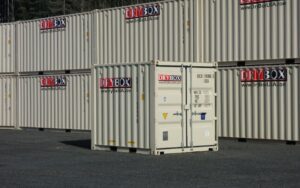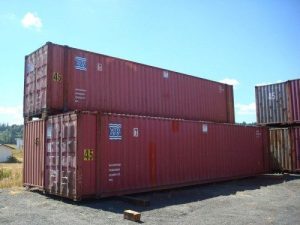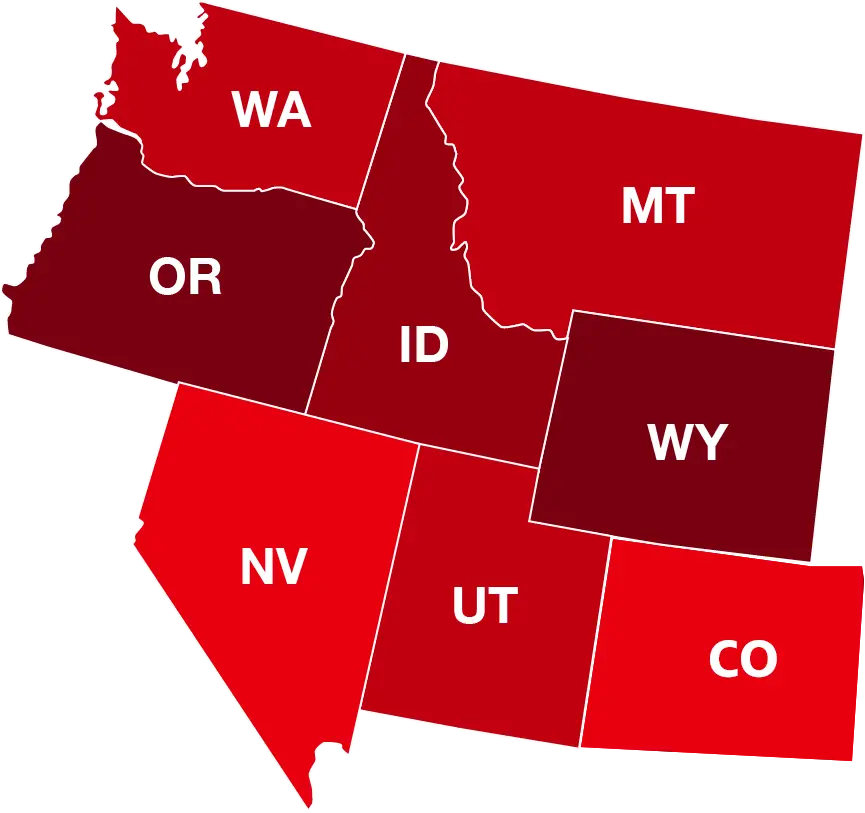9 Shipping Container Sizes to Know and Why They’re Important
Shipping containers transport goods across oceans and continents, store our excess belongings, and are even transformed into innovative homes, offices, and event spaces.
When designing a shipping container to fit your needs, knowing the different sizes available and how they can be used is essential.
At Dry Box, we rent and sell nine shipping container sizes. Keep reading to check out how our containers can be used to accommodate your project.

Shipping Container Sizes
Shipping container sizes are crucial to understand because they directly impact the container’s utility.
Dry Box offers a range of sizes to cater to various needs:

8ft Containers
Compact and convenient, these containers are perfect for small storage or transportation needs.
Homeowners love 8ft containers for additional storage space directly on their property, and because these containers are on the smaller side, it is easy to maneuver them into tight places.
Businesses that require a compact container to ship a smaller number of goods can also benefit from an 8ft container, as they are especially easy to transport.

10ft Containers
A bit larger, these containers offer more storage space while still being easily transportable. They’re great for storing school sports equipment and tools on construction sites.
10ft containers also make amazing mobile businesses and pop-up shops. You can easily travel to different events, and your products will remain secure from theft when your shop is closed.
Let’s look at the dimensions of a ten-foot container:
- External Length: 10ft.
- Internal Length: 9ft. 2in.
- External Width: 8ft.
- Internal Width: 7ft. 7in.
- External Height: 8ft. 6in.
- Internal Height: 7ft. 8in.
- Door Width: 7ft. 8in.
- Door Height: 7ft. 5in.
Due to manufacturer variations, the internal dimensions may vary slightly but these numbers provide a solid basis for your research.
The maximum gross weight for a 10ft container is 22,400 lbs. The tare weight (the weight of the container when it’s empty) is 2,870 lbs. This makes the payload capacity (or the amount of weight in materials) 19,530 lbs.
Another variable among containers is the weight. The weights listed for each container may vary slightly, due to the manufacturer and door types. A cargo door, for example, will weight more than a rollup door. Still, these figures will give you a good idea of how much cargo you can plan to ship.
10ft containers are some of the most compact containers you’ll find. These are best suited for small packing and storage needs.
If you have a studio apartment or a small business to relocate, a 10ft container often meets your needs. With lower tare rates and smaller dimensions, you’re looking at cheaper shipping costs and a smaller carbon footprint.

15ft Containers
These containers provide a balance between space and portability. 15ft containers are commonly used for shipping more significant quantities of goods or for converting into comfortable mobile offices and tiny homes.
They’re also ideal for busy construction sites needing a break room for workers or a bit more secure, temporary storage than a 10ft container provides.
Here are the dimensions on a 15ft container:
- External Length: 15ft.
- Internal Length: 14 ft. 10 in.
- External Width: 8 ft.
- Internal Width: 7 ft. 8 in.
- External Height: 8 ft. 6″
- Internal Height: 7 ft. 10 in.
As with many containers, you might want to examine the difference between cargo doors or rollup doors. If there won’t be a lot of room to swing your doors open wide, then you might want to consider rollup doors.
Instead of a small studio apartment, if you’re moving a one or two-bedroom apartment, a 15ft container might be better suited to your needs. Fifteen footers can hold the contents of up to 1,200 sq. ft. This means they’re also great for people that require temporary storage during a move.

20ft Containers
Standard-sized shipping containers are 20ft, and they have many potential uses.
They’re commonly used for shipping goods overseas, but they’re also popular for converting into more spacious tiny homes, offices that accommodate multiple people, and larger shops.
Here are the dimensions of a 20ft container:
- External Length: 20 ft.
- Internal Length: 19 ft. 4 in.
- External Width: 8 ft.
- Internal Width: 7 ft. 8 in.
- External Height: 8 ft. 6 in.
- Internal Height: 7ft. 10in.
- Door Width: 7ft. 8in.
- Door Height: 7ft. 5in.
The maximum gross weight for a twenty-foot container is 66,139 lbs. The tare weight is 4,850 lbs. This makes the payload capacity 66,139 lbs.
20ft containers are the most common containers and regularly used for shipping container garages, tiny homes, mobile offices, and workspaces.
In fact, they’re one of our most popular shipping container sizes. They’re great for both residential and commercial moves. 20ft containers are the best container size for approximately four to six rooms. They can house home furnishings, office equipment and furniture, and more.

22ft Containers
Slightly larger than the standard size, 22ft containers can still fit comfortably on many homeowner’s properties while offering even more storage space.
These containers can store larger items like ATVs, motorcycles, a single car, jet skis, and a compact sailboat.

24ft Containers
If your property has enough open land to accommodate a 24ft container, they make excellent shipping container swimming pools. Also, artists needing an affordable studio or looking to open a transportable gallery may consider a 24ft container.

40ft Containers
These containers offer a vast amount of storage space. They’re perfect for shipping large quantities of goods or storing equipment for big events.
Construction companies can also reliably store and transport large machinery in 40ft containers, like forklifts, excavators, and bulldozers.
Here are the dimensions on a 40ft container:
- External Length: 40ft.
- Internal Length: 39ft. 5in.
- External Width: 8ft.
- Internal Width: 7ft. 8in.
- External Height: 8ft. 6in.
- Internal Height: 7ft. 10in.
- Door Width: 7ft. 8in.
- Door Height: 7ft. 5in.
The maximum gross weight for a forty-foot container is 66,139 lbs. The tare weight is 8,380 lbs. This makes the payload capacity 57,759 lbs.
40ft containers are quite spacious and convenient. As for residential needs, we usually see families with a two or three-bedroom home, living room, den, dining room, and kitchen buy or rent these containers.
They also come in handy when large pieces of machinery need to be safely transported, such as loaders, excavators, and other equipment and supplies.

45ft Containers
With a weight limit of nearly 60,000 pounds, 45ft containers are ideal for large-scale shipping. These containers are also great for family mobile homes and can easily be converted into communal offices for larger businesses.
Here are the dimensions of a 45ft container:
- External Length: 45 ft.
- Internal Length: 44 ft. 4 in.
- External Width: 8 ft.
- Internal Width: 7 ft. 8 in.
- External Height: 9 ft. 6in.
- Internal Height: 7 ft. 9 in.
The payload capacities for 45ft containers are very similar to 40ft containers. But, here’s where things get interesting. You can see the standard eight-foot width and eight-foot six-inch height. But, 45ft shipping containers are often secured at 9 ft. 6 in.
That extra foot makes these containers great candidates for commercial, industrial, and rural purposes. They’re secure and watertight, creating extra storage at a work location with ground-level access. Of course, they’ll also remain secure and tight during transport.

53ft Containers
These are the biggest containers offered by Dry Box, and the possibilities are nearly endless. 53ft containers are great venues for hosting large-scale events and are perfect for creating a sustainable restaurant.
Here are the dimensions on a 53ft container:
- External Length: 53 ft.
- Internal Length: 52 ft. 6 in.
- External Width: 8 ft. 5 in.
- Internal Width: 8 ft. 2 in.
- External Height: 9 ft. 5 in.
- Internal Height: 8 ft. 11 in.
The maximum gross weight for a fifty-three-foot container is 67,200 lbs. The tare weight is 11,110 lbs. This makes the payload capacity 56,090 lbs.
53ft containers have 60% more capacity than 40-foot containers. When there’s a lot of cargo at stake, these containers allow shippers to consolidate their goods into fewer containers.
Standard Shipping Container Size
Ports vary in size, with smaller ports seeing a handful of cargo ships arriving each day and hundreds of cargo ships docking at busier ports on any given day.
In the early 1960s, the International Organization for Standardization, or ISO, determined that a designated standardized shipping container size would make global shipping more efficient.
To keep handling consistent and make the loading and unloading process as seamless as possible, the ISO coined the 20ft shipping container as the standard size.
The standard shipping container size is 20ft because it balances space and portability. A 20ft container provides ample room for most goods and is manageable to transport efficiently.
This standardization has dramatically increased global trade efficiency and made the 20ft container a staple in the shipping industry.
Shipping Container Sizes for Homes
When building homes out of shipping containers, most people opt for the 40ft size. This size offers a good balance between living space and manageability.
However, it’s essential to shop around for varying sizes and get the best deal, as prices can vary significantly from size to size.
Pro Tip:
Combining multiple containers can also create more complex home designs.
Consider maximizing your container home’s space with multiple containers if that option is financially feasible.
A 40ft container can be a dual living and dining room, a 22ft container is perfect for a luxury kitchen, and 8ft containers are large enough for a spacious main bath.
Practical Uses of Shipping Containers
Shipping containers are incredibly versatile and can be used to accommodate a variety of special projects, including:
Garages
Shipping containers can be converted into secure, weatherproof garages. Their sturdy construction makes them ideal for storing vehicles, tools, and other equipment.
The larger containers, such as the 40- or 45ft sizes, can accommodate multiple vehicles. A 53ft container makes a great auto repair garage if you’re a mechanic.
Storage
Whether you need to store household items, business inventory, or construction materials, shipping containers provide a secure and weatherproof solution. Storage on your property makes accessing personal items simple, as you can avoid trips to a traditional storage facility.
Schools
Schools often utilize shipping containers for storing event and sports equipment. Since modifications can be made to shipping containers, like adding HVAC systems and insulation, they can even be converted into cafeterias, computer labs, and classrooms.
Events
Shipping containers are incredibly versatile for events. They can be used for storing decorations and merchandise, as ticket booths, concession stands, and as office spaces or breakrooms for event staff.
Larger containers can even be used as indoor venues. One of the main benefits of using shipping containers for events is their portability, as they can be moved and used again for future events.
Farming & Greenhouses
Shipping containers work well on farms as they can safely house livestock and securely store farm equipment. Shipping container greenhouses are an innovative alternative to traditional farms, and one of the main benefits is that they can even be used in large cities.
Contact Dry Box
Ready to find the perfect shipping container for your needs?
Contact Dry Box today and explore the creative possibilities of our nine shipping container sizes.









